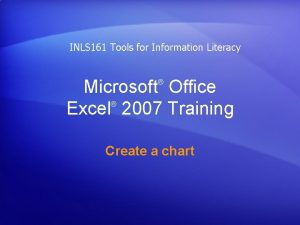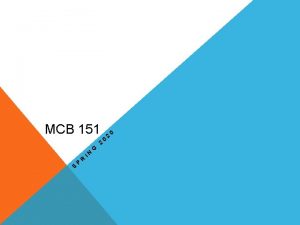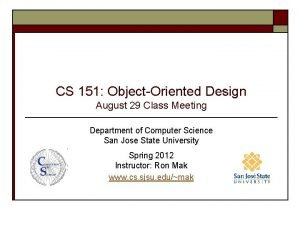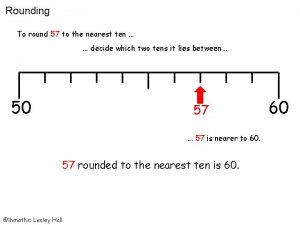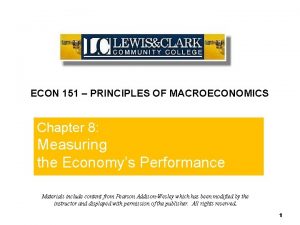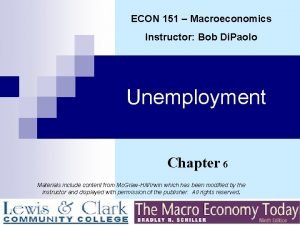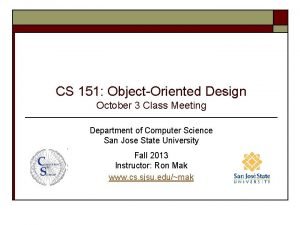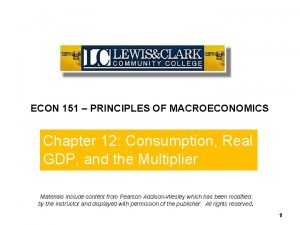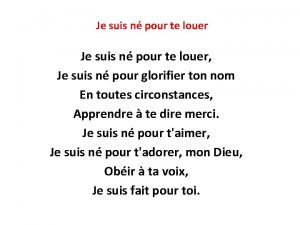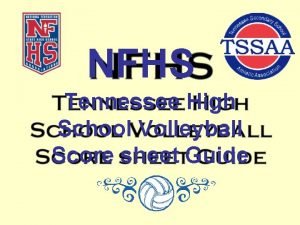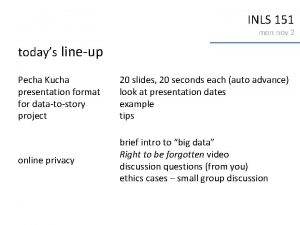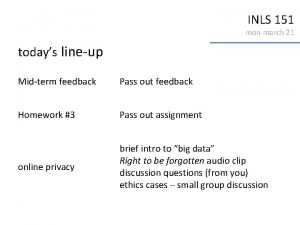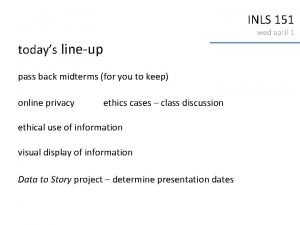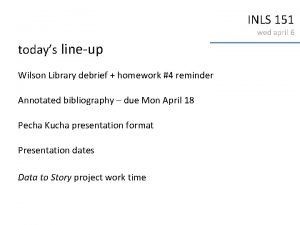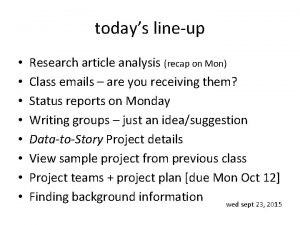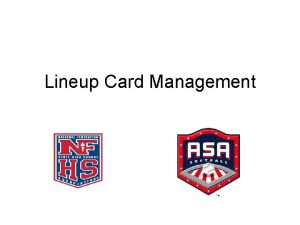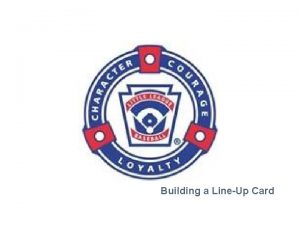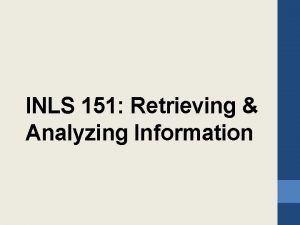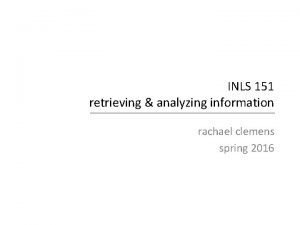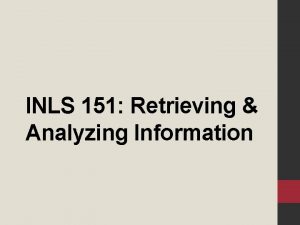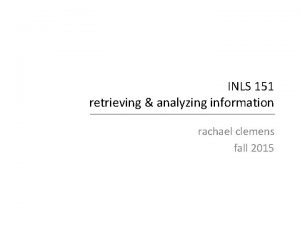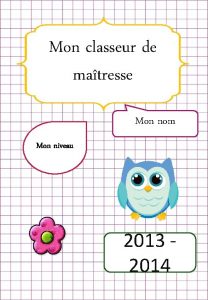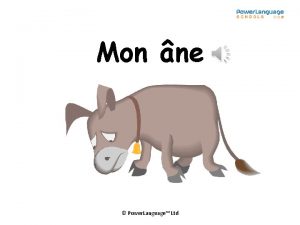INLS 151 mon mar 2 2015 lineup article






















- Slides: 22

INLS 151 mon, mar 2, 2015

line-up… • article analysis – pass out feedback • what statistics to use for project? • background info & statistics – Pew Research, Statista, Statistical Abstracts of the U. S. • literature databases • search operators – subject headings / controlled vocabulary – Boolean operators – proximity operators • handout/discuss midterm

Pass out feedback

General comments… • Appropriate use of vocabulary • Effectively used evaluation criteria from handout • The term data is plural – can work around this by using “dataset” – These data… – This dataset… • Make sure to get the PDF (displays as presented in the actual journal issue – with charts and graphs) • Use of quotations in your paper – varies according to discipline

Project Description • Identify selected variables (including any subsets) – e. g. SEX=FEMALE, AGE=18 -30, INCOME, LAW 5=YES • What sort of relationship among these variables will you try to analyze? – e. g. we are interested in young women who have been arrested and what sort of income level they report • What sort of story are you interested in uncovering? – We are interested describing young adult females who have been incarcerated – what sort of social support systems help these offenders get back on the right track to become contributing members of society. We may also look at children of incarcerated mothers – what challenges do they face and what are some ways to help prevent a cycle of poverty and incarceration? • • What types of information/statistics/facts do you plan to look for to help you develop the story? Describe your team work plan – – • • how will you divide the work? who will pursue which element? how will you share information? what is your timeline? Include names of all teammates if applicable Due by class time on Wednesday (I will meet in class with each person/group)

Team 1 2 3 4 5 6 7 8 9 ? Members James, Caitlin, Bill & Matt Emily, Josh & Porsha Grace, Henry, Javairia & Benny Terry Cherish Greg Sophia, Ryan, Rickell & Mark Alex, Ben, Charlie, Maddie Lucy, May & Emma Kaley, Erin, Sam

Project: variables + statistics • Could use only 1 variable (frequency, descriptive – mean, median, mode) • Could use 2 categorical variables and use contingency tables (crosstabs) + Chi squared • Could focus on certain responses (select cases) + frequency table Think about what you WANT to look at and we’ll figure out how…

Statistical Sources Pew Research Center collect their own data Free Statista collect own data + other sources Statistical Abstracts of the U. S. based on census data free + subscription UNC Lib Historical Statistics of the U. S. based on census data free + subscription UNC Lib http: //www. pewresearc h. org/ Subscription UNC Lib

http: //www. pewresearch. org/

Pew Research Center is a nonpartisan fact tank that informs the public about the issues, attitudes and trends shaping America and the world. It conducts public opinion polling, demographic research, media content analysis and other empirical social science research. Pew Research does not take policy positions. It is a subsidiary of The Pew Charitable Trusts.

Statista • Sample search: viral videos • Sample search: Groupon

Pop quiz 1. In the context of an information retrieval system, what is a controlled vocabulary? 2. If an information retrieval system has a controlled vocabulary, how would using it improve your search experience?

What is a controlled vocabulary? • A controlled vocabulary is a list of terms (words or phrases) or codes (notation) used for indexing • Almost always, controlled vocabularies show relationships among terms

Subject headings • Subject headings are a set of terms or phrases (known as controlled vocabulary) that classify materials. • Essentially they identify and pull together under a common umbrella information about a given subject. • Most online catalogs and databases use some form of subject headings, though they may also be called descriptors or keywords.

What are the types of alternative fuels being used or developed for automobiles? alternative fuels automobiles electricity ethanol natural gas fuel cells cars vehicles transportation motor vehicle


Abbreviations BT - Broader Topic - Use to expand your search using a broader topic. NT - Narrower Topics - Use to focus your search using a narrower topic. RT - Related Topic - Alternative terminology for your topic. UF - This is the appropriate subject heading is use for these words. DO NOT search by words listed as UF. USE - Identifies the correct heading to use for your topic.


UNC Library Homepage: http: //library. unc. edu/ E-research by discipline Academic Search Complete Handout: Academic search complete


PROXIMITY OPERATORS allow you to specify searches where one word is near, next to, or in the vicinity of another word adj specifies that one word is adjacent to another in a document before/# specifies that the first word is within # words and before the second word near/# specifies that the first word is within # words of the second word

In-class exercise • Using the worksheet strategies, complete either search task #1 or #2 • Share with class
 Inls 161
Inls 161 Mcb 101 uiuc
Mcb 101 uiuc 118/151
118/151 Cs 151 sjsu
Cs 151 sjsu Apsc 151
Apsc 151 Hino 151
Hino 151 Dpr 151/2011
Dpr 151/2011 Cs specializations uci
Cs specializations uci 71 to the nearest 10
71 to the nearest 10 1,151,725 bytes
1,151,725 bytes Econ 151
Econ 151 Econ 151
Econ 151 Tổng kết vốn từ 151
Tổng kết vốn từ 151 Chm 151 final exam
Chm 151 final exam Sucrose solubility curve
Sucrose solubility curve A software consists of
A software consists of Sjsu cs 151
Sjsu cs 151 Item 151
Item 151 Model-netics
Model-netics Determinants of consumption
Determinants of consumption Je suis né pour te louer partition
Je suis né pour te louer partition Police photo lineup generator
Police photo lineup generator Volleyball score sheet
Volleyball score sheet
